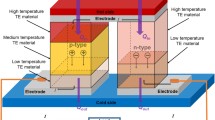Abstract
The thermoelectric (TE) power output, \(f_P\), and conversion efficiency, \(f_{\eta }\), for segmented thermoelectric generators (TEGs) have been optimized by spatially distributing two TE materials (BiSbTe and Skutterudite) using a numerical gradient-based topology optimization approach. The material properties are temperature-dependent, and the segmented TEGs are designed for various heat transfer rates at the hot and cold reservoirs. The topology-optimized design solutions are characterized by spike-shaped features which enable the designs to operate in an intermediate state between the material phases. Important design parameters, such as the device dimensions, objective functions and heat transfer rates, are identified, investigated and discussed. Comparing the topology optimization approach with the classical segmentation approach, the performance improvements of \(f_P\) and \(f_{\eta }\) design problems depend on the heat transfer rates at the hot and the cold reservoirs, the objective function and the device dimensions. The largest performance improvements for the problems investigated are \(\approx \) 6%.
Similar content being viewed by others
References
D.M. Rowe, Thermoelectrics Handbook: Macro to Nano, 1st edn (CRC Press, 2005).
C.B. Vining, Nat. Mater. (2009). https://doi.org/10.1038/nmat2361.
G.J. Snyder and T.S. Ursell, Phys. Rev. Lett. 91, 148301 (2003). https://doi.org/10.1103/PhysRevLett.91.148301.
R. Bjørk, J. Electron. Mater. (2015). https://doi.org/10.1007/s11664-015-3731-7.
M.P. Bendsøe and N. Kikuchi, Comput. Method Appl. Mech. (1988). https://doi.org/10.1016/0045-7825(88)90086-2.
M. Bendsøe and O. Sigmund, Topology Optimization Theory, Methods, and Applications, 2nd edn (Springer, 2003).
E.E. Antonova and D.C. Looman, Int. Conf. Thermoelectr. (2005). https://doi.org/10.1109/ICT.2005.1519922.
C. Lundgaard and O. Sigmund, Struct. Multidiscip. Optim. (2018). https://doi.org/10.1007/s00158-018-1919-1.
Z. Bian and A. Shakouri, Int. Conf. Thermoelectric. (2006). https://doi.org/10.1109/ICT.2006.331365.
Y.C. Gerstenmaier and G. Wachutka, J. Appl. Phys. (2017). https://doi.org/10.1063/1.4994642.
Z. Tian, S. Lee, and G. Chen, Ann. Rev. Heat Transfer (2014). 2014006932. https://doi.org/10.1615/AnnualRevHeatTransfer.2014006932.
C. Lundgaard and O. Sigmund, Appl. Energy (Accepted for publication) (2018).
A. Rezania, K. Yazawa, L.A. Rosendahl, and A. Shakouri, Int. J. Therm. Sci. (2013). https://doi.org/10.1016/j.ijthermalsci.2013.05.002.
N. Wojtas and C. Hierold, Int. J. Therm. Sci. (2013). https://doi.org/10.1109/Transducers.2013.6627032.
M.M. Barry, K.A. Agbim, and M.A. Chyu, J. Electron. Mater. 44(6), 1394–1401. https://doi.org/10.1007/s11664-014-3380-2.
S. Bélanger and L. Gosselin, Int. J. Energy Res. (2011). https://doi.org/10.1002/er.1820.
A. Martínez, J.G. Vian, D. Astrain, A. Rodríguez, and I. Berrio, J. Electron. Mater. (2010). https://doi.org/10.1007/s11664-010-1291-4.
Z. Zhang, L.N. Chen, Z.J. Chen, G.Q. Xiao, and Z.J. Liu, J. Electron. Mater. (2015). https://doi.org/10.1007/s11664-015-3754-0.
C. Favarel, J.-P. Bédécarrats, T. Kousksou, and D. Champier, Energy Convers. Manag. (2016). https://doi.org/10.13044/j.sdewes.2015.03.0020.
X. Gou, H. Xiao, and S. Yang, Appl. Energy (2010). https://doi.org/10.1016/j.apenergy.2010.02.013.
J. Esarte, G. Min, and D.M. Rowe, J. Power Sources https://doi.org/10.1016/S0378-7753(00)00566-8 (2001).
R.O. Suzuki, Y. Sasaki, T. Fujisaka, and M. Chen, J. Electron. Mater. (2012). https://doi.org/10.1007/s11664-012-2074-x.
J. Yu and H. Zhao, J. Power Sources (2007). https://doi.org/10.1016/j.jpowsour.2007.07.045.
R. Bjørk, A. Sarhadi, N. Pryds, N. Lindeburg, and P. Viereck. Energy Convers. Manag. (2016). https://doi.org/10.1016/j.enconman.2016.04.042.
A. Sarhadi, R. Bjørk, N. Lindeburg, P. Viereck, and N. Pryds, Energy Convers. Manag. (2016). https://doi.org/10.1016/j.enconman.2016.04.052.
Y. Ma, Q. Hao, B. Poudel, Y. Lan, B. Yu, D. Wang, G. Chen, and Z. Ren, Nano Lett. (2008). https://doi.org/10.1021/nl8009928.
A. Muto, J. Yang, B. Poudel, Z. Ren, and G. Chen, Adv. Energy Mater. (2013). https://doi.org/10.1002/aenm.201200503.
T.S. Ursell and G.N. Snyder, Int. Conf. Thermoelectric. (2002). https://doi.org/10.1109/ICT.2002.1190349.
P.H. Ngan, D.V. Christensen, G.J. Snyder, L.T. Hung, S. Linderoth, N. Van Nong, and N. Pryds, Phys. Status Solidi A (2014). https://doi.org/10.1002/pssa.201330155.
S.P. Yushanov, L.T. Gritter, J.S. Crompton, and K.C. Koppenhoefer, in Proceedings of the 2011 COMSOL Conference, Boston, USA (2011).
R.D. Cook, D.S. Malkus, M.E. Plesha, and R.J. Witt, Concepts and Applications of Finite Element Analysis, 4th edn (Wiley, New York, 2007).
P. Michaleris, D.A. Tortorelli, and C.A. Vidal. Int. J. Numer. Methods Eng. (1994). https://doi.org/10.1002/nme.1620371408.
J.K. Guest and J.H. Prévost, Int. J. Numer. Methods Eng. (2006). https://doi.org/10.1002/nme.1560.
O. Sigmund, Struct. Multidiscip. Optim. (2007). https://doi.org/10.1007/s00158-006-0087-x.
A. Sakai, T. Kanno, K. Takahashi, H. Tamaki, H. Kusada, Y. Yamada, and H. Abe, Sci. Rep. UK (2014). https://doi.org/10.1038/srep06089.
W. Seifert and V. Pluschke, Phys. Status Solidi A (2014). https://doi.org/10.1002/pssa.201330392.
Y. Yang, S.H. Xie, F.Y. Ma, and C.H. Lei, J. Appl. Phys. (2012). https://doi.org/10.1063/1.3674279.
W. Seifert, E.Müller, and S. Walczak, Int. Conf. Thermoelectric. (2006). https://doi.org/10.1109/ICT.2006.331241.
Y.C. Gerstenmaier and G. Wachutka, Phys. Rev. E (2012). https://doi.org/10.1103/PhysRevE.86.056703.
D.M. De Leon, J. Alexandersen, J.S. Jun, and O. Sigmund, Struct. Multidiscip. Optim. (2015). https://doi.org/10.1007/s00158-015-1279-z
Author information
Authors and Affiliations
Corresponding author
Rights and permissions
About this article
Cite this article
Lundgaard, C., Sigmund, O. & Bjørk, R. Topology Optimization of Segmented Thermoelectric Generators. J. Electron. Mater. 47, 6959–6971 (2018). https://doi.org/10.1007/s11664-018-6606-x
Received:
Accepted:
Published:
Issue Date:
DOI: https://doi.org/10.1007/s11664-018-6606-x



